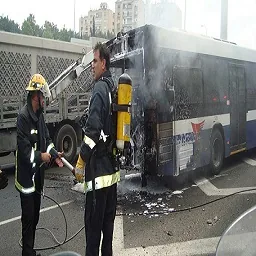Common Carrier Safety in California
I’m Ed Smith, a Fresno truck accident lawyer. While commercial and school bus crashes occur less frequently than car accidents, when they do it can be catastrophic due to the number of passengers and lack of safety restraints and airbags. In addition, the weight and size of the vehicles can mean significant injury when passenger vehicle occupants or pedestrians are involved. In the United States, approximately 30 bus accidents occur daily with injury to about 70 passengers.
Common Carriers
Buses, including city, school, tour and long-distance commercial buses as well as taxis, are considered common carriers. Generally, a vehicle that can transport nine or more passengers for a fee falls into this category. Common carriers operate under federal and state regulations that demand operators provide a duty of care to passengers and adhere to regional, state and federal traffic laws.
School Buses
Overall, school buses are safer than other types of vehicles. In fact, according to the National Highway Traffic Safety Administration, a young person is about 70 times safer when traveling on a school bus. However, fatalities, although fewer, are horrific for both the community and parents alike.
Seat Belts on School Buses
In the past, the NHTSA did not require seat belts on school buses, saying that the cost of outfitting a school bus with restraints would average about $8,000 per bus and that the bus would be unable to carry as many students due to the difference in the number of seats to accommodate the seat belts. In 2008, NHTSA said that three-point seat belts would be required on all buses that weigh less than 10,000 pounds. However, it was left to the states to decide if it should be done with buses over that weight. In 2015, NHTSA reversed itself and required that all school buses should have three-point seat belts.
California School Bus Seat Belt Law
In California, school buses that transport more than 16 passengers must have three-point seat belts if built after July 1, 2005. Other school buses manufactured after July 2004 are also required to have seat belts. The students must be educated on how to use the seat belts in a way that is understandable to them, depending on their age.
Tour Buses
Tour bus accidents in 2014 resulted in the deaths of 44 passengers in the state. In addition, 244 pedestrians or passengers of other vehicles were also killed. A big part of the problem is the lack of inspections. The Federal Motor Carrier Safety Administration, due to budget issues, allows states to do inspections. California urges bus companies and drivers to do self-inspections, however, buses that are in accidents show that inspections were not done or there was no follow up inspection after deficiencies were found.To counter this trend, a bill was passed that allows the counties and cities to request that the California Highway Patrol do inspections on buses, which is paid for by the counties and the cities who request it. In April 2017, CBS News reported that none have been requested.
City Buses
While passengers on city buses are killed in traffic accidents, the majority are pedestrians, either waiting for or leaving a bus or others passing by. Many accidents of this sort are due to a driver’s failure to follow safety protocols. Distraction plays a big part too on the part of other drivers or the bus driver.
Liability in Common Carrier Accidents
As with other modes of transportation, it is a driver’s duty to provide a reasonable duty of care to passengers. Failing to do that results in a breach of that duty, and the breach was the cause of a person’s injury or death. The injuries or a person’s demise had a financial impact.
Fault may be the result of negligence of a driver or a vehicle code violation. Waiting until a passenger takes their seat or is in a safe area after disembarking is the responsibility of the bus driver. Doors must remain open while a rider is boarding or leaving the vehicle. The doors may have a safety feature, preventing them from closing inadvertently. However, if the feature fails, it may be due to lack of maintenance. In such an event, the company that owns or in charge of the line would be liable for lack of maintenance and negligence in operation of the vehicle. Bus drivers are trained to operate city buses. Failing to do so would reflect poorly on the employer and the employee.
Fresno Truck Accident Lawyer
I’m Ed Smith, a Fresno truck accident lawyer. If you have been injured in a bus crash or lost a member of the family, call me at (559) 377-7676 or outside the calling area at (800) 404-5400 to receive free and friendly advice.
As an injury lawyer, helping Northern California residents, including Fresno and the surrounding area, to obtain just compensation in wrongful deaths and traumatic injuries, I have protected their right to be safe at the hands of others.
My reviews written by former clients can be found on my Yelp, Avvo and Google pages.
If you go to settlements and verdicts, you will see the way some cases have been resolved.
Members of the Million Dollar Advocates are trial attorneys who have won cases for one million dollars or greater. I belong as a California forum member.
Autoaccident.com is the website I founded and own. It offers useful and comprehensive information about topics in personal injury law.
Photo Attribution: https://pixabay.com/en/bus-accident-fire-fire-department-72213/
:cd [cs 935] cv

